 |
47 (8) (1995), pp. 49-54. JOM is a publication of The Minerals, Metals & Materials Society |
|---|
 |
47 (8) (1995), pp. 49-54. JOM is a publication of The Minerals, Metals & Materials Society |
|---|
At the core of the development of the IDGE is the desire to understand and to measure the characteristics of an isolated, freely growing, dendrite. The physical understanding and mathematical description of how dendritic patterns emerge during the growth process (particularly the dendrite's tip velocity and radius of curvature as a function of the applied supercooling) are of interest to both scientists and engineers, and they constitute the central subjects of the IDGE. Background research leading to the shuttle-based experiment is described in the sidebar.
After creating the obligatory acronym (IDGE), teams at Rensselaer and Lewis began in earnest to develop the space flight experiment. Rensselaer was responsible for designing and building an experimental growth chamber to meet the rigors of spaceflight as well as for all the scientific analysis and reporting. The Lewis team had primary responsibility for overseeing the development and construction of the experimental instrument, including its integration in the shuttle system. They were also responsible for meeting NASA's rigorous reliability and quality assessment requirements for a manned space vehicle.
Before obtaining official flight-experiment status and receiving permission to build flight-quality hardware, every proposed experiment must pass a series of critical reviews. Completing this series of reviews usually takes several years.
Generally, the first review encountered is the Conceptual Design Review. Here, the project must present the science objectives for the flight experiment and verify, with a rough design, that a concept has been worked out that can be further developed to accomplish the science objectives. This is followed by the Science Concept Review (called the Requirements Review at the time of this work). At this stage, the final science requirements must be approved as a Science Requirement Document. The document guides the design, engineering, and integration of the instrument, and must specify all the experimental parameters and protocols, conditions, scientific background, and justification for flight. In addition, a detailed concept of the hardware development that includes both the schedule and the budget must be submitted for approval. If approved, the projected is funded for flight and attains flight experiment status. Next, the Preliminary Design Review is held as an informational briefing so that interested parties who may be working with the project can be appraised of its continuing progress. The final review is the Critical Design Review, where the project must present a complete set of designs, backed up by critical engineering tests, to convince the review panel that the instrument described in the designs will be built, will operate as described, and will satisfy each of the requirements specified in the Science Requirements Document.
In April 1985, the IDGE satisfied the Conceptual Design Review and was permitted to progress to the next milestone—the Requirements Review. The initial science requirements from the 1985 Science Requirements Document were for the IDGE to develop the following: a method of repetitive crystal seeding for orientation control of repetitive dendritic growth sequences; an autonomous millidegree thermostat for orbital application over periods of approximately three days; a launch-compatible crystal-growth chamber; data acquisition and recording for sample temperature, interface velocity, high-resolution photomicrography, and acceleration; and flight hardware that satisfies design limits such as apparatus temperature, power, weight, volume, and flight safety.
In 1985, the program management at NASA headquarters suggested to the IDGE team, as an alternative, that the science requirements be revised and to prepare for the Requirements Review not as a small mid-deck experiment but as a larger, more capable cargo-bay payload experiment. This change entailed several trade-offs. For example, the overall experiment would become considerably more complex and expensive as an operating environment would be needed for the experiment inside an experiment apparatus container that would be maintained outside the controlled ("shirt-sleeve") mid-deck environment. Also, the experiment would have to be autonomous (i.e., setting temperatures, growing dendrites, and photographing dendrites without benefit of an astronaut or payload specialist to make minor repairs or adjustments). However, the hardware limitation on power, weight, volume, and safety would be easier to meet. Further, the operating time on-orbit would accommodate 20 dendritic growth cycles over a period of six days as opposed to a mid-deck experiment with eight astronaut-assisted growth cycles over a three-day period. The IDGE team decided that the overall trade-offs were favorable to upgrading the IDGE to a autonomous payload-bay experiment.
The revised Science Requirement Document was completed by March 1986. At that time, the IDGE was officially manifested as part of the Microgravity Science Laboratory, which was subsequently enlarged and renamed the United States Microgravity Payload (USMP). The USMP is responsible for integrating and distributing space shuttle resources and data to and from several cargo-bay experiments, including from the Space Acceleration Measurement System.
At about the same time, studies conducted at Rennselaer concluded that it was impractical to develop the orientation control needed for accomplishing the repetitive crystal seeding. Specifically, the proposed fixed-focus IDGE photographic system, which relied on exercising orientation control, would not always deliver high enough resolution for accurate tip-radius measurements. The solution chosen to overcome the uncertainties in growth orientation was to change the fixed-focus optics to a modified shadowgraphic system that would provide the larger depth of focus needed, even without controlled seeding. This approach, however, decreased the resolution of the photographs.
Both the optics modification and payload experiment modification were incorporated in the Preliminary Design Review of April 1987;(13) afterward, the manufacture and testing of prototype engineering hardware began. In April 1988, the IDGE project underwent the Critical Design Review. At that time, a follow-on Critical Design Review was suggested by the review team so that the IDGE project could proof test their designs more thoroughly before being scheduled for launch on a particular USMP flight. Although such reviews are not mandatory, they are quite common. By the time of the follow-on review, held in December 1989, the IDGE team had built, filled, grown, and photographed dendrites in engineering-prototype growth chambers.(14) The IDGE was then officially manifested on the USMP-2 on the STS-62 for an anticipated launch in June 1992 (a date that would ultimately "slip" to March 1994).
Final flight hardware manufacture and testing had to be completed at launch minus 10 months (L-10). Turnover of the IDGE hardware to the Kennedy Space Center integration teams was scheduled no later than L-6 months. Before the turnover could take place, the project needed to pass two additional formal reviews. The Science Readiness Review, where the principal investigator must convince an expert scientific panel that the as-built hardware delivers the proposed science as specified earlier in the Science Requirements Document. The last review is the Pre-Ship Review, where the project must demonstrate to an engineering panel that the flight hardware was built as specified, that the workmanship meets all NASA requirements, and that it operates routinely and repeatably as specified.
During April 1993, with the launch scheduled for February 1994, NASA headquarters conducted the Science Readiness Review. Soon after, the IDGE flight hardware was configured for flight, and a series of critical ground-based experiments were conducted to test the flight systems further and to generate a reliable set of dendritic growth data for comparison with the flight experiment results. In late June 1993, after the test phase was almost complete and prior to shipping the flight apparatus to Kennedy Space Center for integration with the shuttle, the project was presented to the peer Pre-Ship Review panel at the Lewis Research Center. For final approval, the findings of this panel were presented to the director of the Space Flight Systems Directorate (the supra organization to the Space Experiments Division) and the director's Pre-Ship Review panel.
The director's Pre-Ship Review entailed a highly unusual event. After the completion of the peer Pre-Ship Review, but before the director's Pre-Ship Review, the thermoelectric cooler, a critical element of the automated dendritic growth initiator system, failed—constituting a dreaded single-point failure for the experiment. The project team immediately informed the chair of the peer review board and preceded to diagnose the cooler failure and develop an appropriate fix. Fortunately, backup parts were available and pretested so that the flight hardware was repaired to working operation. Thus, the IDGE team was retesting the repaired flight hardware during the director's Pre-Ship Review. At that review, the peer review board chair submitted the board's revised findings and unanimously recommended that the IDGE be shipped to the Kennedy Space Center for flight integration contingent upon the successful completion of a full-up mission simulation. However, the review board also noted that because of the failure of the thermoelectric cooler, the growth chamber was considered a risk item. Based on the IDGE project's assessment, this was considered a risk that could be taken.
At the space center in late July 1993, after another full set of ground simulation tests showed that the apparatus was still working properly, the special film for the flight experiment was loaded into the cameras, and the IDGE apparatus was fully assembled, not to be disassembled until after completion of the flight. The apparatus was then officially turned over to the integration teams at Kennedy Space Center to be mechanically fastened to the USMP-2 carrier and connected to communication and power buses as well as freon cooling loops. After integrating all the primary experiments, the entire USMP carrier was integrated into the payload bay of the space shuttle Columbia. The IDGE team's only contact with the flight instrument was during the scheduled functional tests in September and October 1993, which confirmed, after some troubleshooting and repair of a balky cable connection on the carrier, that the proper integration to the carrier and the shuttle were accomplished.
Between November 1993, when the last functional tests were completed, and March 3, 1994, when the shuttle was scheduled for launch, the IDGE team and the other USMP-2 experiment teams met four times at the MSFC for training, simulation, and joint integrated simulations. During this same time period, the IDGE team performed several science simulations using the engineering prototype hardware. In these simulations, the team produced dendritic growth data, analyzed the data, and replanned the simulated experiment as if it were an actual space flight.
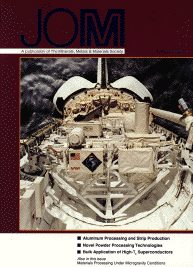
In May 1994, the IDGE film was retrieved from the apparatus at the off-line laboratory at Kennedy Space Center. In June, the film was developed by NASA using specially designed procedures at the Lewis Research Center. Figure 1 shows a series of dendritic growth photographs from the spaceflight experiment. Since then, the task of data reduction and analysis has been performed. The results of these analyses are the subject of ongoing publication.(16-18) Although a full discussion of the results would not be appropriate here, a illustrative sample is provided.
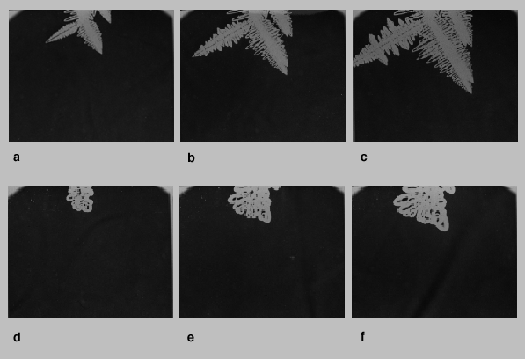
Figure 1. Two photo sequences of dendritic growth from the spaceflight experiment at supercoolings of approximately (a-c) 1.0 K and (d-f) 0.1 K.
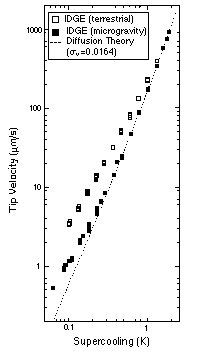
Figure 2. Measured dendritic growth velocities under microgravity and terrestrial conditions.
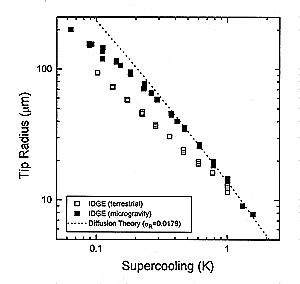
Figure 3. Measured dendritic growth radii under microgravity and terrestrial conditions.
In addition, several important metascience-level conclusions have been reached about the best use of space flight facilities. The total development time for a flight experiment—from the concept and ground-based studies to postflight data analysis and reporting—can be lengthy. Scientific success ultimately requires long-term support of and commitment to the investigators. An initial investment of time and money in ground-based studies, for its own sake, and ground-based studies evolving toward a flight experiment are absolutely mandatory. The ground-based studies create the framework on which the critical experimental questions are framed, and they in turn provide the requisite experimental expertise to define and envision specific microgravity studies. The flexibility of the IDGE team in making changes, installing upgrades, and performing fixes to the flight instrument greatly contributed to the overall success experienced on USMP-2.
Tele-operational controls enabled optimization of finite resources, such as film capacity and orbital time, to accomplish specific goals despite several unpredicted events. We did not anticipate, for example, several eventualities encountered in the operation of the experiment. Without tele-operational control, the IDGE team would not even have known about some surprises until several months after the flight. Certainly we could not have altered the preset operational parameters to either avoid, or take advantage of those surprises and, in the process, improve the quality and quantity of the scientific data return.
We continued the augmentation of tele-operational control capability well after the IDGE instrument was handed over to the Kennedy Space Center engineers by modifying our operating procedures, running additional science mission simulations, and adding features to our Payload Operation and Control Center activities up to the week before launch. These late changes were done much to the consternation of the Payload Operation and Control Center support crew, who nevertheless met all of our needs. This experience underscores the fact that without operations, and this includes the support teams at all the NASA centers involved, there can be no microgravity science.
Finally, and personally, our experience on the IDGE give support of our view that the best benefit of microgravity research in materials science is not to make something in space, but to try and gain scientific understanding.
2. G.P. Ivantsov, Dokl. Akad. Nauk, USSR, 58 (1947), p. 56.
3. M.E. Glicksman, R.J. Schaefer, and J.D. Ayers, Met. Trans. A, 7A (1976), p. 1747.
4. J.S. Langer and H. Muller-Krumbhaar, Acta Metall., 26 (1978), pp. 1681, 1689, and 1697.
5. D. Kessler, J. Koplik, and H. Levine, Phys. Rev. A, 34 (1986), p. 4980.
6. Y. Miyata, M.E. Glicksman, and T.H. Tirmizi, J. Crystal Growth, 112 (1991), p. 683.
7. E.A. Brener and V.I. Mel`nikov, Adv. Phys., 40 (1991), p. 53.
8. NASA Research Announcement, "Microgravity Materials Science: Research and Flight Experiment Opportunities," NRA-94-OLMSA-0 (December, 12, 1994).
9. S.C. Huang and M.E. Glicksman, Acta Metall., 29 (1981), p. 701, and, M.E. Glicksman and S.C. Huang, Convective Transport and Instability Phenomena, ed. Zierep and Ortel, Karlsruhe, (1982), p. 557.
10. R. Ananth and W.N. Gill, Chemical Eng. Comm., 68 (1988), p. 1.
11. R. Ananth and W.N. Gill, J. Crystal Growth, 91 (1988), p. 587.
12. R. Ananth and W.N. Gill, J. Crystal Growth, 108 (1991), p. 173.
13. J. Robert Schrieffer, review of Microgravity Science and Applications Flight Programs (University Space Research Association, Washington, D.C., 1987).
14. E.A. Winsa et al., Reprint AIAA 95-0610, 33rd Aerospace and Sciences Meeting and Exhibit, Reno NV (January 1995).
15. M.B. Koss et al., 7th International Symposium on Experimental Methods for Microgravity Science, ed. R.A. Schiffman (Warrendale, PA: TMS, in press).
16. M.E. Glicksman, M.B. Koss, and E.A. Winsa, Phys. Rev. Lett., 73 (1994), p. 573.
17. M.E. Glicksman et al., Adv. Space Res., 16 (7) (1995), p. 181.
18. M.E. Glicksman et al., Advances in Casting, Welding and Advanced Solidification Processes VII (Warrendale, PA: TMS, in press).
ABOUT THE AUTHORS
Martin E. Glicksman earned his Ph.D. in physical metallurgy at Rensselaer Polytechnic Institute in 1961. He is currently John Tod Horton Professor of Materials and Chemical Engineering at Rensselaer Polytechnic Institute. Dr. Glicksman is a member of TMS.
Matthew B. Koss earned his Ph.D. in condensed matter physics at Tufts University in 1989. He is currently a research scientist at Rensselaer Polytechnic Institute.
Edward A. Winsa earned his M.S. in engineering science at Toledo State University in 1972. He is currently a project manager and a project scientist at NASA Lewis Research Center.
For more information, contact M.E. Glicksman, Rensselaer Polytechnic Institute, Materials Research Center, Troy, New York 12180; (518) 276-6712; fax (518) 276-8554; e-mail glickm@rpi.edu.
The growth of dendrites in pure melts is known to be controlled by the transport of latent heat produced at the moving crystal-melt interface as it advances into its supercooled melt.(1) Ivantsov, in 1947, published the first mathematical solution to the dendritic heat diffusion problem(2) and modeled the dendrite as a paraboloidal body of revolution, growing at a constant velocity. The resultant thermal diffusion field can be expressed mathematically in paraboloidal coordinates, moving with the dendritic tip, and is known as the Ivantsov or diffusion solution. This analytic solution is, however, incomplete, insofar as it specifies only the tip growth Péclet number, VR/2[[alpha]] (V is growth velocity, R is the tip radius of curvature, and [[alpha]] is thermal diffusivity of the molten phase), as a function of supercooling. The Péclet number obtained from the Ivantsov solution for each supercooling yields an infinite number of velocity and radius pairs that satisfy the diffusion solution at that particular value of the supercooling [[Delta]]T, but not the explicit velocity and radius. It is the nonuniqueness of the growth Péclet number in terms of V and R that indicates that the Ivantsov treatment underspecifies the dendritic growth problem.
The early experimental data gathered on the interface velocity of some pure transition metals such as nickel and cobalt provided more of a qualitative test of theory because there were no corresponding morphology measurements from which the tip radius could be determined. In these experiments, the velocity measurements themselves had a large scatter (20-50%), and the thermophysical properties needed for theoretical calculation were at the time either unavailable or inaccurate. In the early 1970s, Glicksman and coworkers at the Naval Research Laboratory used succinonitrile (SCN), a body-centered cubic organic plastic crystal, as a model system for studying dendritic growth.(3) This was possible because SCN solidifies like cubic metals (i.e., with an atomically rough solid-liquid interface). SCN proved advantageous because it exhibits convenient characteristics for solidification experiments, such as a low melting temperature, optical transparency, and the potential for accurate characterization of its thermophysical properties. These early dendritic growth studies on SCN accurately measured tip velocities as a test of theory. Specifically, this study showed that the then-current concept of combining the Ivantsov solution with the so-called maximum velocity hypothesis neither explained nor predicted the observations.
Considerable theoretical effort within the scientific community has since concentrated on trying to discover an additional equation or independent length scale, which, when combined with the Ivantsov diffusion solution, selects the observed dendritic operating states.(1,4-7) Although the underlying physical mechanisms accounting for these theories of the second length scale might be quite different, they invariably provide a scaling law in which VR(2) is a constant. This scaling law is usually expressed through a scaling constant

where do is the capillary length scale, which is a materials parameter defined from the equilibrium temperature of the crystal-melt interface energy, the solid-liquid interface energy, and the specific and latent heats. Although some dendritic theories predict the value of this scaling constant, in practice the scaling constant is used as a convenient adjustable parameter to correlate dendritic growth data in a given system.
NASA Research
The first SCN dendritic growth data provided ample evidence that heat transfer due to natural, buoyancy-driven convection modified the diffusional heat transfer. To study the effect of gravity on dendritic growth, one of the authors (Glicksman) developed a ground-based research program supported by the Materials Processing in Space Program office at NASA headquarters. Scientific liaison was provided through the Space Processing Applications Rocket (SPAR) program at NASA's Marshall Space Flight Center (MSFC). Today, support for such programs may be sought from the NASA Microgravity Science and Application Division through its periodically released NASA research announcements (see, for example, Reference 8).
The role played by gravity on dendritic growth, was elucidated in the work of Glicksman and Huang, who made simultaneous measurements of V and R as a function of supercooling, and as a function of the angle between the primary dendrite's [100] axis and gravity. This data set proved that gravity (hence, convection) is an important factor in dendritic growth.(9) Photographs of dendritic tips growing in different orientations with respect to gravity show qualitatively that gravity matters (Figure A). Specifically, in the lower supercooling range, gravity-induced convection actually dominates dendritic growth, an effect that totally confounds any analysis based on diffusive heat and mass transfer. There has been some analysis estimating the effects of natural or forced convection on dendritic growth,(10-12) but these calculations always rely on as yet unproven elements of dendritic growth theory and, consequently, cannot provide an independent test of theory. In the higher supercooling range, where convective influences diminish, the morphological structure of dendrites becomes too small to resolve optically at the growth speeds encountered.
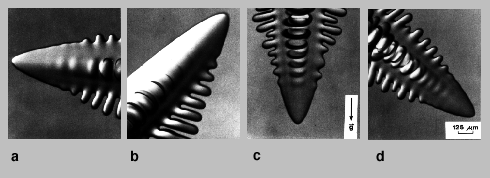
Figure A. Succinontrile dendrites shown in true growth orientation with respect to gravity.
After the publication of these results in 1981 and 1982, the MSFC investigated
the practicality of designing an experiment for a flight opportunity on a small
sounding rocket to eliminate or reduce the convective effects during dendritic
growth. It was concluded that it was neither worth the investment (about $1
million) nor the effort to achieve only five minutes of suborbital microgravity
time—at best, this would permit the acquisition of only one data point.
However, a new option in low-gravity research was becoming available. NASA was
developing a reusable space transportation system (STS), commonly known as the
space shuttle.
Direct questions about this or any other JOM page to jom@tms.org.
| Search | TMS Document Center | Subscriptions | Other Hypertext Articles | JOM | TMS OnLine |
|---|